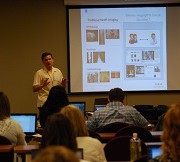Multi-Site Pharmaceutical Trial
A multi-site clinical trial, led by Principal Investigator (PI) Dr. James McCracken of UCLA, is designed to measure the effects of an investigational product to mitigate social disability Changes in social functioning will be measured through the use of structured assessments that are administered by trained raters. The variability in rater’s skill levels with these kinds of assessments administered at multiple sites can potentially mask a significant effect of the investigational product.
On HIPAA-conforming Behavior Connect-for Clinical Trials, the PI or designated clinicians at one site can watch the recorded assessment that took place at other sites, and then rate the behaviors observed during the assessment. This method of scoring will help to control for variability introduced by multiple raters with varying skills. As part of this clinical trial the Social Communication Interaction Test (SCIT) will be performed in examination rooms at 4 different sites around the country, Behavior Capture™ Online technology will automate the video images of these assessments to be securely uploaded to Behavior Connect for subsequent review by the PI to help him perform:
1. Inter-site Reliability checks
2. ease-of centralized scoring of primary assessments
3. Post hoc “microanalysis” of video’s assessments
Use of Behavior Imaging during this study should show “proof of principle” that Behavior Imaging can improve multi-site clinical trial methodology for variety of symptoms associated with various brain disorders.
Study Goals
The goals of this study are to Implement a System to Allow 4 Clinical Sites to Share Behavior Images to Improve Multi-site Operations of Ongoing Assessments:
a. Use of video capture technology in the proposed FAST-ASD Clinical Trial will require developing and implementing video capture technology in interview rooms with the ability of the clinician to control video enabling during the interview and to review and annotate video clips at a future time.
b. Support Principal Investigator(PI) and others regarding Security, Regulatory and Documentation Requirements for Behavior Connect 2.0 to have System compliant with IRB and other regulations
c. Ensure that each Clinical Site participant is able to use Behavior Capture to archive and securely share Assessment interactions via video capture
d. Customize Behavior Connect – Clinical Trials online Platform Customized for the Right Clinical UI Interface for PI to Interact with Clinicians at Multiple Sites, ‘Rate’ Video assessments in Behavior Connect, and other desired features he may want to improve project oversight
e. Maintain Technical and Client Support throughout FAST-ASD to ensure that platform can be accessed and used by authorized users identified by PI
f. Assess PI’s, Gold Standard Rater(s), and Remote Clinicians’ Perspective of use of Behavior Connect
g. Write Report re multiple stakeholders’ Strengths, Weaknesses, and Recommendations



